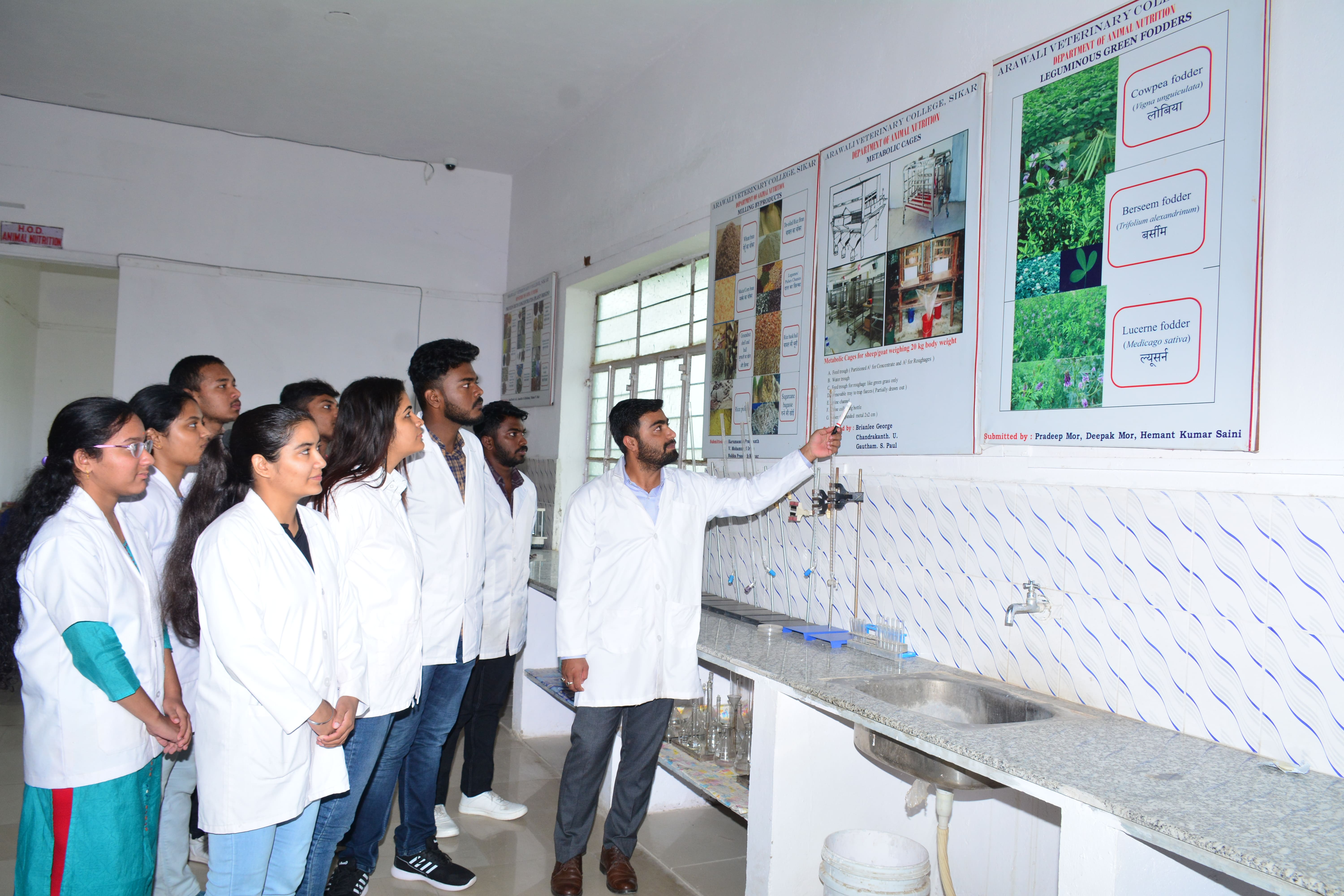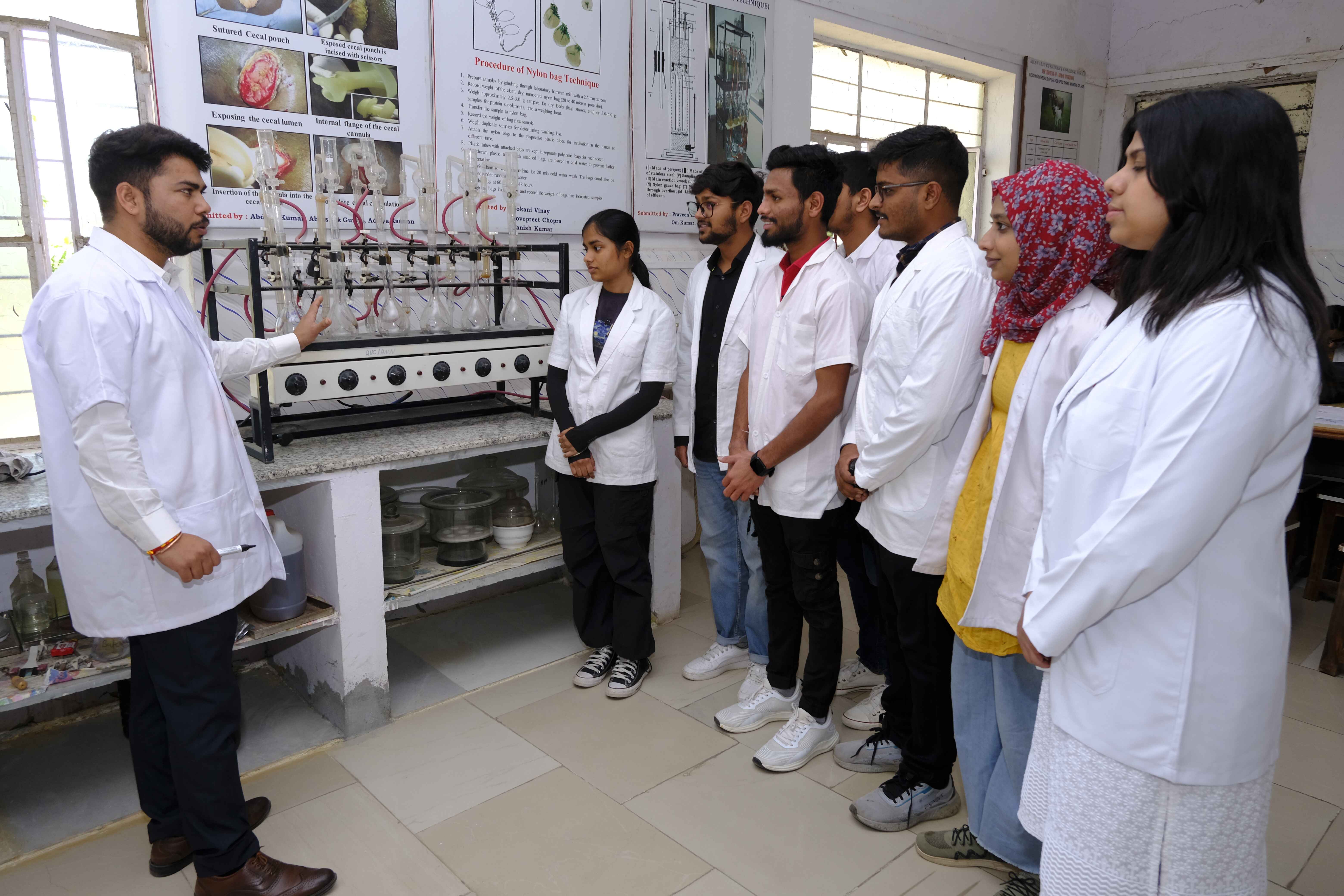

Department of Animal Nutrition: This department offers courses in animal nutrition with the objective of assessing nutrient requirements and methods for assessing te energy and protein requirements for maintenance and production in terms of growth, reproduction, milk, meat, wool and draft purpose. The department is well equipped to impart practical training as per prescribed syllabi.
The Department has the following sanctioned strength of Faculty:
Professor - 1
Associate Professor – 1
Assistant Professors – 1
S.No.
|
Name
|
Designation
|
Qualification
|
Service Period at AVC
|
Photo
|
Biodata |
|
01
|
Dr. Pawar Shivaji
|
Professor
|
B.V.Sc & AH, M.V.Sc and PhD
|
15.11.2024 to till Continue
|
 |
Biodata |
|
02
|
Dr. Sonali Namdeo
|
Assistant Professor
|
B.V.Sc & AH, M.V.Sc and PhD
|
02.01.2025 to 25.07.2025
|
 |
|
|
03
|
Dr Shendage Vishwajeet Jagannath
|
Assistant Professor
|
B.V.Sc & AH, M.V.Sc
|
29.10.2025 to till Continue
|
|
Biodata |
COURSES AND SYLLABI
THEORY
UNIT-1 (PRINCIPLES OF ANIMAL NUTRITION AND FEED TECHNOLOGY)
History of animal nutrition. Importance of nutrients in animal production and health. Composition of animal body and plants. Nutritional terms and their definitions. Nutritional aspect of carbohydrates, protein and fats. Role and requirement of water, metabolic water. Importance of minerals (major and trace elements) and vitamins in health and production, their requirements and supplementation in feed. Common feeds and fodders, their classification, availability and importance for livestock and poultry production. Measures of food energy and their applications - gross energy, digestible energy, metabolizable energy, net energy, total digestible nutrients, starch equivalent, food units, physiological fuel value. Direct and indirect calorimetry, carbon and nitrogen balance studies. Protein evaluation of feeds - Measures of protein quality in ruminants and non-ruminants, biological value of protein, protein efficiency ratio, protein equivalent, digestible crude protein. Calorie protein ratio. Nutritive ratio. Introduction to feed technology- Feed industry; Processing of concentrates and roughages. Various physical, chemical and biological methods for improving the nutritive value of inferior quality roughages. Preparation, storage and conservation of livestock feed through silage and hay and their uses in livestock feeding. Harmful natural constituents and common adulterants of feeds and fodders. Feed additives in the rations of livestock and poultry and their uses.
UNIT-2 (APPLIED RUMINANT NUTRITION-I)
Importance of scientific feeding. Feeding experiments. Digestion and metabolism trial. Norms adopted in conducting digestion trial. Measurement of digestibility. Factors affecting digestibility of a feed. Feeding standards, their uses and significance, merit and demerits of various feeding standards with reference to ruminants. Balanced ration and its characteristics.
UNIT-3 (APPLIED RUMINANT NUTRITION-II)
Nutrient requirements and methods for assessing the energy and protein requirements for maintenance and production in terms of growth, reproduction, milk, meat, wool and draft purpose. General principles of computation of rations. Formulation of rations and feeding of dairy cattle and buffaloes during different phases of growth and production (neonate, young, adult, pregnant, lactating and dry animals; breeding bull) and working animals. Formulation of ration and feeding of sheep and goat during different phases of growth and production (milk, meat and wool). Feeding of high yielding animals and role of bypass nutrients. Metabolic disorders and nutritional interventions. Use of NPN compound for ruminants.
UNIT-4 (APPLIED NON-RUMINANT NUTRITION)
Nutrient requirements in poultry, swine and equine - Energy and protein requirement for maintenance and production. Methods adopted for arriving at energy and protein requirements for maintenance and production in terms of growth, reproduction and production (egg, meat and work). Feeding standards for non-ruminants and poultry Formulation of rations as per Bureau of Indian Standards and Indian Council of Agricultural Research specifications. Feeding of swine (Piglets, Growers, Lactating and pregnant sows, Breeding boar, Fattening animals), equine (foal, yearling, broodmare, stallion and race horses) and poultry (Starter, Growers, Broilers, Layers) with conventional and unconventional feed ingredients. Feeding of ducks, quails, turkeys and laboratory animals. Nutrient requirements of mice, rat, rabbit and guinea pig. Diet formulation, preparation and feeding of rabbits and laboratory animals. Nutrient requirement and feeding of different categories of dogs and cats; peculiarities of feeding cats. Feeding of wild animals and birds in captivity. Metabolic disorders and nutritional intervention.
PRACTICAL
UNIT-1 (PRINCIPLES OF ANIMAL NUTRITION AND FEED TECHNOLOGY)
General precautions while working in nutrition laboratory. Familiarisation of various feeds and fodders. Preparation and processing of samples for chemical analysis - herbage, faeces, urine and silages. Preparation of solutions. Weende System of analysis - Estimation of dry matter, total ash, acid insoluble ash, crude protein, ether extract, crude fibre, nitrogen free extract in feed samples. Estimation of calcium and phosphorus. Demonstration of detergent methods of forage analysis. Qualitative detection of undesirable constituents and common adulterants of feed.
UNIT-2 (APPLIED RUMINANT NUTRITION-I)
Calculation of nutritive value of different feed stuffs in terms of digestible crude protein (DCP), total digestible nutrient (TDN), Nutritive ratio (NR) and balance of nutrients.
UNIT-3 (APPLIED RUMINANT NUTRITION-II)
Calculation of requirements of nutrients in terms of DCP, TDN and metabolisable energy (ME) for maintenance, growth, and other types of production like meat, milk, wool, reproduction and draft purpose. Formulation of rations for different categories of livestock under different conditions. Formulation of rations for feeding of livestock during scarcity periods. Visit to Animal Farm and Feed Mill.
UNIT-4 (APPLIED NON-RUMINANT NUTRITION)
Calculation of requirements of nutrients for growth, reproduction and other types of production like egg and meat. Formulation of rations for poultry and swine with conventional and unconventional feed ingredients. Principles of compounding and mixing of feeds. Visit to farms. Formulation of balance diets for horses, dogs and cats. Feeds and feeding schedule of zoo animals and birds-diet charts.
ANNUAL EXAMINATION
PAPERS UNITS MAXIMUM MARKS WEIGHTAGE
THEORY
Paper-I 1 and 2 100 20
Paper-II 3 and 4 100 20
PRACTICAL
Paper-I 1and 2 60 20
Paper - II 3 and 4 60 20
INTERNAL ASSESSMENT 20